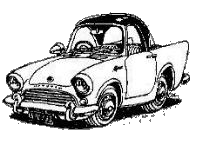
The absence of a folded soft top means that GT models have more space behind the front seats and were more realistic as a two + two seater (rear seat belts and child seats were 'novel' to say the least in the 60s).
In 1968, the Alpine GT was priced at just under a grand (about twice the price of a basic Austin or Morris 850 Mini). Its main competition was from the slightly pricier MGB GT and the Triumph GT6, both of which had a fixed steel roof.
Compared to these competitors, the 1968 Alpine GT was a lot more comfortable and pleasant to drive.
The others of course were lighter and faster and always had a more macho image, even after Sean Connery drove an Alpine in 'Doctor No' and Michael Caine drove one in 'Get Carter'.
Other contemporaries were the Triumph TR5 and Austin Healey roadsters, both with larger engines and rather higher price tags. At the other end of the spectrum were the smaller Spitfire & Spridgets (the Austin-Healey & MGs now a BMC badge-engineering exercise).

Until 1968 the Alpine had the most powerful version of the 1725cc Rootes engine in 'standard' production.
The 1968 Motor Show saw the release of the Holbay H120 variant of the Fastback Rapier (1967 - 1976) with the ultimate version of this engine and many Holbay units (and even more Holbay rocker covers) have found their way into Alpines over the years.
The arrival of the 1725cc engine in 1965 had marked the change from 3 to 5 main crankshaft bearings and from dynamo to alternator powered electrics so the Series V really is the 'ultimate' Series Alpine.
The same basic engine unit, with a variety of power output levels, went on to power the whole of the 'Arrow' range (Hunter, Vogue, Rapier, Sceptre) until their demise in the late seventies.
The Alpine's demise seems to have been down to internal politics within the Chrysler Corporation (who 'merged' with the Rootes Group in 1964) rather than any lack of potential. The Ford powered Tiger stable-mate was a thorn in Chrysler's flesh and rather than re-engineer it with a Chrysler V8 both Tiger & Alpine were killed off early in 1968.
Lamentably, the Alpine name was used again (from 1969 - 1976) for a down-market version of the Fastback Rapier, and eventually for a family hatchback descendant of the Simca 1100 (the Talbot/Chrysler Alpine 1976 - 1985) that eventually became the Peugeot 309!
Early 'Series' Alpine History
In 1959, the (Series I) Sunbeam Alpine was introduced as an open-top Roadster with a 1500cc engine. Like all British Sports Cars, the main component designed specially for it was the body: most mechanicals coming from 'stock'. In the case of the Alpine it was built on a strengthened Hillman Husky floor pan with essentially Sunbeam Rapier mechanical parts, although the aluminium cylinder head and disc brakes were also 'special'.
Unlike all other British Sports Cars however, the design brief included words like 'comfort' & 'style' that had only previously been used for up-market saloons.
The car was fairly successful in the marketplace and for the 1960 Motor Show the car was upgraded to the Series II with better suspension and a 1600cc engine.
Competition successes led to the introduction of the Harrington Alpines with a coach built fixed-hardtop body and performance enhancements. These were produced by Harringtons for a couple of years.
The 1963 Motor Show saw the much improved Series III Alpine with power assistance to the larger brakes, suspension improvements, larger fuel tanks and many other minor changes. The Alpine GT also arrived with the Series III: a detachable hardtop version as an alternative to the soft-top roadster.
The Series IV arrived at the 1964 Brussels Motor Show with largely styling updates such as the re-shaping of the rear fins and the new single bar 'radiator grille'. Automatic transmission also became available (but didn't survive to the Series V) and by the London Motor Show the manual gearbox was 'all synchromesh'.
The final version, the Series V arrived just before the 1965 Motor Show, with its 1725cc, five bearing engine and an alternator replacing the dynamo. Production ceased in 1968.
Links:-